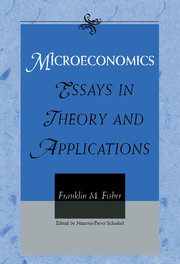Book contents
- Frontmatter
- Contents
- Introduction
- Part I Disequilibrium and Stability
- Part II Welfare Economics and Consumer Theory
- Part III Applications of Microeconomic Theory
- Part IV Industrial Organization, Economics, and the Law
- 24 Organizing Industrial Organization: Reflections on the Handbook of Industrial Organization (1991)
- 25 Reflections on Competition Policy (1993)
- 26 The Social Costs of Monopoly and Regulation: Posner Reconsidered (1985)
- 27 Due Diligence and the Demand for Electricity: A Cautionary Tale (1992)
- 28 Estimating the Effects of Display Bias in Computer Reservation Systems (1990)
- Part V Public Policy Applications
- Epilogue
- Indexes
24 - Organizing Industrial Organization: Reflections on the Handbook of Industrial Organization (1991)
Published online by Cambridge University Press: 20 March 2010
- Frontmatter
- Contents
- Introduction
- Part I Disequilibrium and Stability
- Part II Welfare Economics and Consumer Theory
- Part III Applications of Microeconomic Theory
- Part IV Industrial Organization, Economics, and the Law
- 24 Organizing Industrial Organization: Reflections on the Handbook of Industrial Organization (1991)
- 25 Reflections on Competition Policy (1993)
- 26 The Social Costs of Monopoly and Regulation: Posner Reconsidered (1985)
- 27 Due Diligence and the Demand for Electricity: A Cautionary Tale (1992)
- 28 Estimating the Effects of Display Bias in Computer Reservation Systems (1990)
- Part V Public Policy Applications
- Epilogue
- Indexes
Summary
Turning and turning in the widening gyre
The falcon cannot hear the falconer;
Things fall apart; the centre cannot hold;
Mere anarchy is loosed upon the world.
W. B. Yeats, “The Second Coming”Bliss was it in that dawn to be alive,
But to be young was very heaven!
William Wordsworth, “French Revolution”Parts 2 and 3 of the Handbook of Industrial Organization are respectively entitled “Analysis of Market Behavior” and “Empirical Methods and Results.” The first section is almost exclusively theoretical, whereas the second, as its title makes clear, is empirically oriented. Both sections deal with the analysis of markets, particularly with oligopolistic ones.
Reflection on the Handbook has two aspects. First, is the Handbook a good book – that is, does it succeed in its stated aims? The second suggests a broader and more important set of questions. Reading the Handbook provides the opportunity for thinking about the state of the art, about the field of industrial organization. What does it include? What are the organizing principles? In what direction is the field growing? Is that the correct destination?
This latter set of questions is the subject of most of this paper. But the first question also deserves attention, and the two are not unrelated.
The Handbook as a Book
In considering the Handbook as a book (and in later assessing the state of the art) I necessarily paint with broad strokes. The Handbook is immense, and a detailed review of its chapters would be tedious, if not impossible.
- Type
- Chapter
- Information
- MicroeconomicsEssays in Theory and Applications, pp. 361 - 383Publisher: Cambridge University PressPrint publication year: 1999



